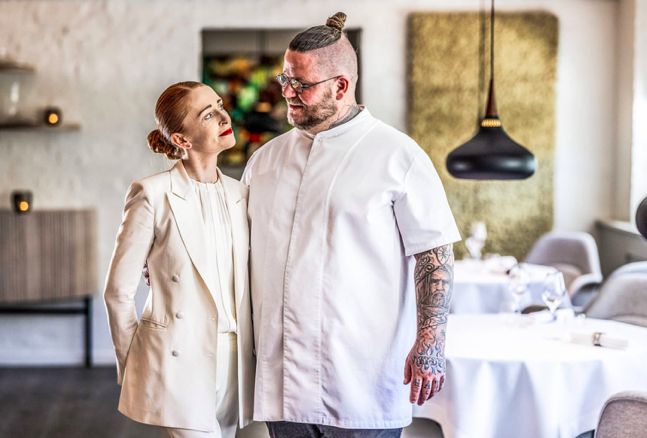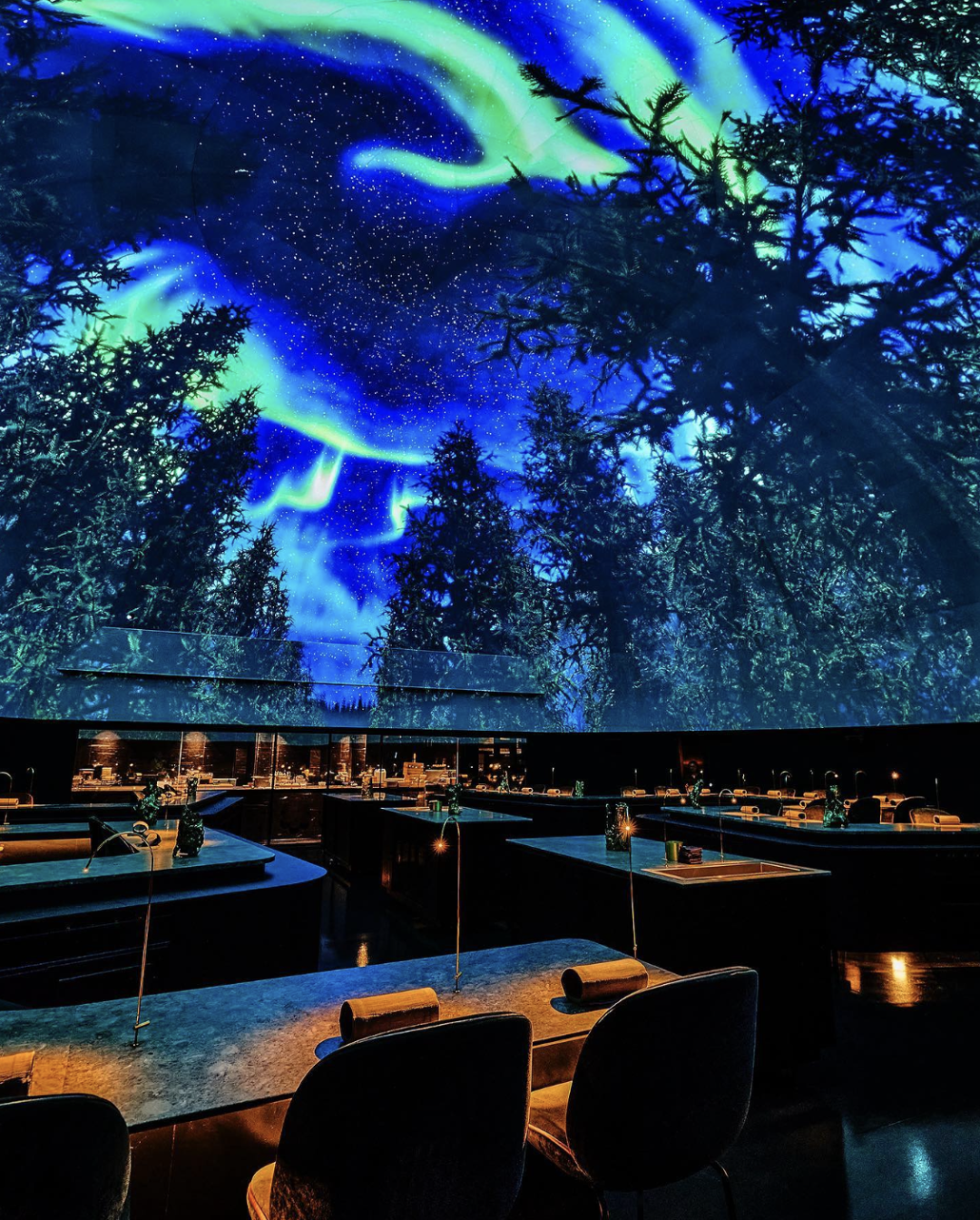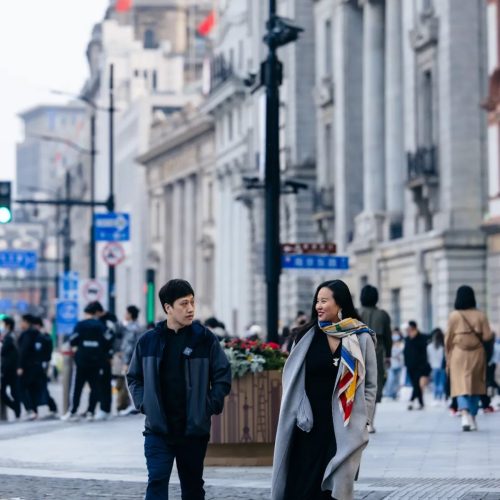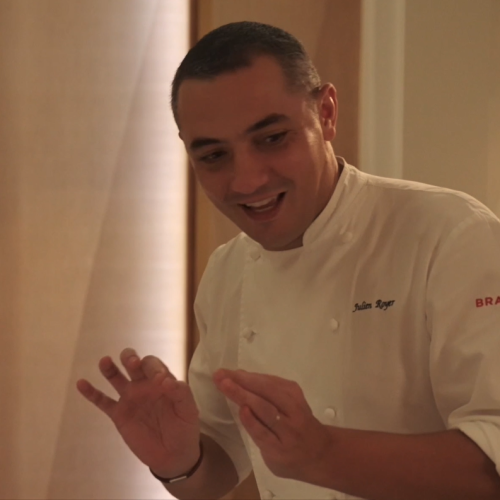Author: Jocelyn Chen
A couple of years ago, I had a quick stop at Amazing Chinese Cuisine at its Hongqiao restaurant. I didn’t order many courses, but it was already enough to strike me as a restaurant that’s committed to quality ingredients.
2018 marks Amazing Chinese Cuisine(Chinese name: 菁禧荟)’s veritable claim of its first Michelin star. When the name of the restaurant was announced at the Michelin Guide Award Ceremony, I almost burst into a laugh over this funny little pun. Sometimes my foreign friends would ask for food recommendations; when I said, “Amazing Chinese Cuisine,” they would always reply, “Which Amazing Chinese Cuisine?” And I needed to explain that it is actually the name of the restaurant. I thought the translation is rather straightforward but in a witty way, which would make people think that the owner of the restaurant must have a good sense of humour. However, there’s an earnestness and reserve that’s endearing when I first met Du Jianqing, owner of Amazing Chinese Cuisine.


The terrace of Amazing Chinese Cuisine The Bund
From left to right: Du Jianqing, owner of Amazing Chinese Cuisine, author, Monica Luo, media director of Paul Pairet Restaurants
Speaking of Amazing Chinese Cuisine, what dishes come to your mind? Crispy Sea Cucumber, Chilled Threadfin Fish, or Braised Fish Maw in Chaozhou Style?
The signature dish Crispy Sea Cucumber carefully selects dried organic Australian golden sandfish. Fully soaked in water, the sea cucumber is simmered over low heat in Chaoshan seafood stock made from flounder fish, dried shrimps, and scallops for two hours, and then its skin is roasted until crispy and garnished with slices of dried scallops. This allows the umami dish to acquire a sun-kissed golden hue and a unique crispy on the outside but soft and chewy inside texture treasured by diners since the restaurant’s opening.

Crispy Sea Cucumber

Chilled Threadfin Fish
Fish Rice or “heu bung” (鱼饭) is a time-honoured dish created by Chaoshan locals. You might be surprised that fish is the only ingredient here, eaten as the usual staple – rice. So, there is in fact no rice, in the Fish Rice. Bit like a humblebrag, eh? Fresh fish is cooked in Chaoshan sea salt brine, and then drained and cooled to retain its original flavour. The rich fat from the fish lends lusciousness and tenderness to the taste. Adopting traditional techniques, Amazing Chinese Cuisine debones Nagasaki mackerel fish, and upgrades to pair the fish rice with a unique savoury and earthy flavour from Puning bean paste sauce.
Chaozhou-Style Braised Fish Maw uses plump, freshly harvested fish maw, sun-dried, soaked in cold water for at least five days, then stewed in hot water until perfectly soft-crunchy. Only the thickest part in the centre of the fish maw is taken. Unlike the Cantonese style that uses abalone sauce, Chaoshan style slowly simmers fish maw in a stock made with aged chicken, pork ribs, lean pork, dried flounder fish, and scallops and dried shrimps – a process that yields luminous, mellow, slightly gooey fish maw.

Chaozhou-Style Braised Fish Maw

Stir-fried Baby Mussels with Garden Peas

Steamed Pork Ribs

Green Mung Bean Cakes with Salted Lemon Flavour
Apart from these must-haves, I especially like some homemade dishes. Stir-fried Baby Mussels with Garden Peas boasts fresh plump peas and juicy mussel pulps.
With an air of Cantonese style, Steamed Pork Ribs is one of the childhood favourites for Du Jianqing. He recalled that his father didn’t usually cook but would always make this dish during the Spring Festival. Drop a pinch of sweet potato powder, a dash of soy sauce, and some pressed garlic, the ribs are then brought to steam without adding any water with bite-size white radish chunks underneath. The buttery soft radish is there to fully absorb the gravy flavour from the ribs and tastes absolutely divine.
In addition, the made-to-order Green Mung Bean Cakes with Salted Lemon Flavour presents light and creamy green bean paste, taking in salted lemon flavour that creates a surprisingly harmonious consistency. This elegant mould shaped delicacy is so beautiful to look at and tasty to boot. Right now, these abovementioned dishes help explain Amazing Chinese Cuisine’s carefully crafted, innovative cuisines.
Chaozhou cuisine
Chaozhou cuisine (also Teochew cuisine) is originated from the Chaoshan region in the eastern part of China’s Guangdong province, which includes the cities of Chaozhou, Shantou and Jieyang. It is a high-end branch of Cantonese cuisine and reputed one of the most well-received cuisines in China. Chaozhou cuisine is approached differently in its style by Chaoshan locals and Hong Kong people, but it bears similarities to Japanese cuisine in terms of ingredients, cooking methods and techniques. Well known for serving raw marinated dishes light on oil and salt, the much less heavy-handed Chaoshan cuisine suits the modern palate for a healthy-eating trend. Part of China’s eastern seaboard on the border of the mountainous Fujian province, Chaoshan’s unique geographical conditions naturally endow the local cuisine with tremendous advantages to be high in the rank among Cantonese cuisine.
“People from places like Hong Kong, Macao and Taiwan have a special feeling towards Chaozhou cuisine. Because of Chaozhou merchants’ diaspora, their families often went to expand their business in Southeast Asian countries such as Malaysia and Singapore, and that’s why you see many old Chaozhou-style buildings there. These returnees would be thrilled to see traditional Chaozhou dishes like raw marinated crabs and aged goose head,” Du Jianqing said.
Modern Chaozhou cuisine
When Du was conceptualizing his catering business, he was quite hesitative about what type of cuisine to offer in his first venture. Sufficiently conversant with the catering industry, styles of cuisine and chefs from various regions, he found that diners in Shanghai have had their pick of restaurants mostly specializing in creative Chinese cuisine, Chaozhou-Cantonese cuisine and fusion cuisine at that time. There was hardly any restaurant specializing high-end Chaozhou cuisine in Shanghai, if any, only serving old-fashioned Chaozhou dishes with superannuated ornaments of tomato and cucumber slices as they did 30 years ago. Unfortunately, neither the restaurants nor their mind-set has managed to evolve with the changing dining scenarios and the emerging food culture.
Moving away from the rough and fuddy-duddy way of presenting Chaozhou cuisine, Du decided to instil creative concepts and ideas into his Modern Chaozhou cuisine (新潮菜), a witty wordplay where the character Chao (潮) represents Chaozhou but also indicates popular trends and inventiveness.
When Amazing Chinese Cuisine launched its signature menu of Modern Chaozhou cuisine, competitors were still lagging behind concepts like modern Huaiyang or modern Peking cuisine. As if on cue, Shanghai in around 2015 saw a boom of local cuisines and regional cuisines from other countries, waving popular tides for modern Chaozhou cuisine to ride.


Many dishes of traditional Chaozhou cuisine still retain conventions from the coastal region and its fishermen. For example, they only use ingredients sourced from the Chaoshan region for dishes like chilled fish head and chilled bigeye fish. But in fact, bigeye fish there is not fatty enough to taste good. Besides, random fish and shrimps are simply not for Du’s posh restaurant, which after all, has only 5 private dining rooms. The ingredients used deserve to be more extravagant in quality and sophisticated in presentation, which naturally requires specialized knowledge and unique sense to sift through and upgrade. Therefore, what’s really centric in Du’s approach to modern Chaozhou cuisine is how he manages to put together a nice range of best-quality ingredients for his customers.
Hairtails, pomfrets and yellow croakers are best from Zhoushan, Taizhou, Ningbo and nearby areas in Zhejiang province, while lion-head geese and whelks are best from Chaoshan’s coastline. Each locality shines with its representative speciality. “We don’t necessarily use the fish from our hometown, because we’ve always laid our eyes on better options. Together with Chaoshan techniques in cooking, we strive to present a perfect whole,” said Du Jianqing.


Encoded with a Chaozhou gene in the blood of Amazing Chinese Cuisine, the restaurant has been building and honing all of its dishes around Chaozhou style of cuisine.
“Refined authentic Chaozhou cuisine takes up 60% on our tasting menu, and about 20% is innovative Chaozhou cuisine, another 20% being fusion Jiangnan cuisine, which is mainly showcased in appetizers. We tried to blend in Chaoshan ingredients in the cold dish platter as the Jiangnan region pays special attention to appetizers,” Du Jianqing said. Grounded in a thorough understanding of Chaozhou cuisine, Du Jianqing dives deep into the cuisine of his hometown to explore innovation possibilities. For example, many people have found that traditional Chaozhou soup dishes are a bit bland in taste, so the restaurant made reasonable adaptation accordingly.
Now you might have heard a few disapproving comments from Chaoshan people on Du’s modern Chaozhou cuisine, but for any it’s justifiable to make adjustments for local cuisine that wants to survive in first-tier cities.
Feeling cool
Du Jianqing embarked on his journey to become a professional cook at the age of 16 when he graduated from high school. His father introduced him to work in Shenzhen as a trainee in a couple of established local Chaozhou cuisine restaurants, including Golden Island Chiu Chow Restaurant, Shenzhen Carrianna Restaurant and New Dynasty Hotel. He started out running chores in the back kitchen, washing dishes and preparing food, which had laid a solid foundation for accumulating his knowledge of Chaozhou cuisine. After five years of immersed learning, he became fascinated by the work of the head chef.

Du Jianqing described, “Tossing the wok is like virtuoso performing acrobatics. The flowing movement and smooth actions are simply so cool.” Because it’s cool, Du began to specialize in a hot kitchen, which requires well-knit skills and precise seasoning, as well as near-perfect dexterity with heat and time.
Gradually he was promoted from assistant chef to head chef, and then joined the Hong Kong team to work at an upscale Chaozhou cuisine restaurant in Chengdu, where he practised for over a year. He came to Shanghai in 1997. That was a time when cuisines from Chaozhou and Hong Kong became predominant dining choices, with high-end seafood restaurants and hotels booming in Shanghai. Chefs from Guangdong and Hong Kong backgrounds were busy running around in a whirlwind of job invitations and business opportunities. Soon later, Du Jianqing gained himself a reputation as a remarkable executive chef who had experience managing a restaurant spanning 4000-5000 square meters, with the kitchen alone taking 1000 square meters. Managing a team of over 300 cooks at the same time was not an easy thing, especially when team members were from different backgrounds and various specialized cuisines.
At busiest time, he needed to work as the chef and consultant for more than 10 restaurants, which he still managed to take on the pressure and responsibilities that come with it. The transition from being a chef to becoming an owner was from around 2006 to 2007, when he invested RMB500,000 to be a stakeholder of a restaurant. He was also in charge of product creation, purchasing, training and recruitment. During his investment, he successfully turned the losing business into an up-and-running restaurant with annual revenue of 30 million yuan.
Not a compromiser
Due to his insistence on quality ingredients and best production, Du Jianqing had clashes with other stakeholders and emphatically withdrew from that catering brand. He had his mind made up to build his own business.
On November 11, 2011, he registered his own company and later in August 2015, he opened the first Amazing Chinese Cuisine in Hongqiao after several years of twists and turns. The bigger restaurant in the Bund Financial Center area was opened in December 2018.
Challenges and achievements
Du Jianqing’s Hongqiao restaurant did not come easy. Restaurant facilities, including water supply, electricity, and gas fitting, had to be reinstalled. Not to mention that late-coming business license delayed by half a year and causing profit loss. Things started to take off 9 or 10 months after opening with the restaurant finally beginning to have regular customers. Amazing Chinese Cuisine is the one and only Michelin-starred Chaozhou cuisine restaurant in mainland China was reminded of Du Jianqing by an overseas Chinese regular.
“Even with the pandemic breaking out at the beginning of 2020, tables for the New Year’s Eve dinner were still fully booked. Partial cancellations were quickly made up by new bookings. From February to April, the turnover was down by at least 10 million yuan, but I only felt obliged to the employees and the restaurant. At the worst time, the restaurant would provide staff with meals every day and have them delivered to the staff dormitories so that they didn’t have to come to the restaurant. By May we were basically back on track,” Du Jianqing said.
When asked about if he plans to expand the chain to other cities, he acknowledged having many expectations for the future, but he’d rather keep a low profile before anything’s been done. Always a hard-working and down-to-earth doer, Du’s obsession for details and quality standards is no secret among fellow professionals. I’d love to address him with a respectful name – boss Du, partly because he somewhat strikes me as an old-school gentleman and elegant businessman back in the early days, only without wearing a tall hat. Or maybe because his humble and earnest charisma has become a rarity these days.
Next year will see Amazing Chinese Cuisine show up at new locations in Shanghai and other cities. Du said the next ten-year plan is still carrying on doing what he is good at – pursuing perfection and craftmanship. His idea is to improve management and offer better cuisine and services.
With the promising future of China’s high-end catering market, Du will be focusing more on product innovation, creating a more refined dining experience and upmarket services for his customers. Internationalization is another thing down the track.




Du described internationalizing Chinese cuisine a tough nut to crack. Innovation is the hardest part because it requires a solid knowledge base, know-how skills and precise control to keep the essential elements of Chinese cuisine. For any restaurant, good food is still the key. Quality ingredients and better taste lie in the heart of everything, whereas beauty is only secondary when it comes to if or not the food tastes good.
I couldn’t tell exactly how many booking calls were taken during the one hour and a half interview with Du. The restaurant’s bookings have been soaring each month since June. The unprecedented growth partly comes from loyal regulars, constituting about sixty percent of its customers. They are usually comfortable well-off people who just need to resume a normal life with a bit of revenge spending after the lockdown.
I asked him, “Then what if you can’t book a table yourself?”
“I guess I will just have to find another place”, I seemed to catch a knowing smile on his face.
Written by: Jocelyn Chen, assisted in the interview: Juliette Zhu
The photos of the dishes are provided by Amazing Chinese Cuisine.
Amazing Chinese Cuisine (Hongqiao)
📍 Villa B5, No. 1665, Hongqiao Road, Shanghai
☎ 021-6262 5677
Amazing Chinese Cuisine (BFC Bund Financial Center)
📍 No. 600, East 2nd Zhongshan Road, Shanghai (No. S401, 4th Floor, BFC Bund Financial Center South Shopping Mall)
☎ 021-6267 7177

Reprint or other cooperation matters
Please contact WeChat account:tastytrip2020
Welcome to follow us
Weibo:TastyTrip
Instagram:_tastytrip_










